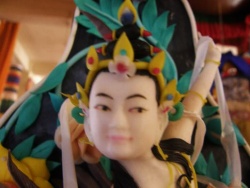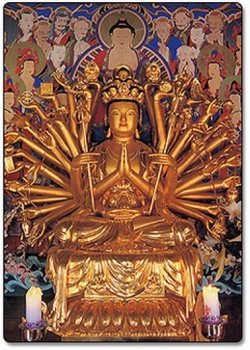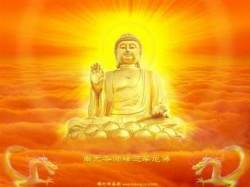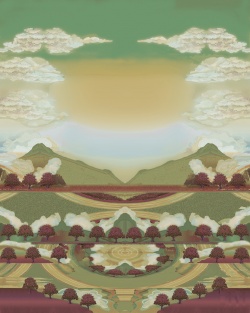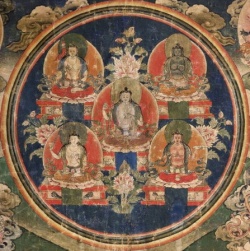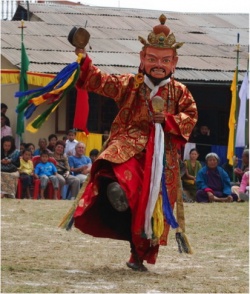Ancient Luy Lau during the Chinese control of Vietnam, in the early centuries A.D.; chapter II
ANCIENT LUY LAU DURING THE CHINESE CONTROL OF VIETNAM, IN THE EARLY CENTURIES A.D.
At the beginning of the modern era, there were three great Buddhist centers in the Han Empire: Luoyang, Pengcheng and Luy Lau (or Lien Lau). Luoyang, which is on the banks of the Luo River, is south of the Yellow river in the northwest of Henan province in China. It was the capital of the Eastern Han dynasty. Historical materials tell that Emperor Huangdi of the Han Dynasty (crowned in A.D. 165) venerated Buddha Sakyamuni and Lao Tzu in one place. At that time Buddhist sutras were translated from Sanskrit into Chinese by Indian and Central Asian monks with the cooperation of Chinese monks. For example: the two Iranian monks, An The Cao and An Huyen, translated Buddhist sutras with a Chinese monk, named Fu Tiao. In Luoyang, there were two big pagodas: Bai Ma Si (White Horse Temple) and Xuchang.
Pengcheng was located in the Chu Kingdom (220-265 A.D.) on the lower part of the Yangzi River which is now in Jiangsu province, China. Here, from the middle of the first century A.D., the gentle folk followed both Taoism and Buddhism. The Chu Emperor Liu Ying (Han Emperor Guangwu’s son) migrated to Pengcheng. And here, he recited prayers to both the transcendence of Taoism and the benevolence of Buddhism. (Ref. The Story of the Chu Emperor Wang Ying in Hou Han Shu). He did penance, fasted, prayed, and made offerings. In the year 265, there was a Buddhist organization consisting of foreign monks and Chinese scholars there.
Luy Lau was the center of Giao Chi, in the center of the Red River Delta which is now Thuan Thanh district, Ha Bac province in Vietnam. From here, there were many water routes and land routes leading to Pengcheng and Luoyang. From early on, Indian and Central Asian traders came here to trade and then monks came to practice or spread Buddhism.
Official Chinese records do not mention the Buddhist situation here at the time because this region was considered to be a remote and barbaric area on the Southern border, not worthy of attention. But it was here that one of the earliest Buddhist Chinese works appeared. It was Ly Hoac Luan which was written by Mau Tu in the second century A.D. From here, also, some famous monks such as Khuong Tang Hoi went to China to spread Buddhism. It is said the Luy Lau Buddhist center was founded earlier than those two centers and that Buddhism was spread from Luy Lau to Pengcheng and then to Luoyang. This seems credible. From various sources, it is possible to understand the Buddhist development in Luy Lau in the early common era.
This story, written in Linh Nam Trich Quai, of how Chu Dong Tu became a monk is well known: Dong Tu and Tien Dung opened shops and traded with many foreign merchants. One day, Dong Tu set off in a boat with a foreign trader. They called at Quynh Vien mountain for fresh water. Dong Tu met an Indian monk in a tent there. The monk taught him Buddhism. Then he stayed on the island to learn Buddhism. He gave gold to his friend to conduct his business and told him to pick him up on the way home. When leaving for home, Dong Tu was given a stick and a hat (made of leaves) which could perform miracles. Arriving back in his country, Dong Tu explained Buddhism to Tien Dung. Later they left their businesses and set out to look for teachers of Buddhism. The traders mentioned in this story must have been Indians who came to our country by sea. From this story, we see how attractive Buddhism was to Vietnamese working people, for both Dong Tu and Tien Dung were only traders. In addition, in Ngo Chi, there was a letter sent by Vien Huy to Tuan Huc in 207 A.D.
In the letter, there is a paragraph praising Si Nhiep (‘Shishee’ in Chinese) for keeping Giao Chau peaceful for more than 20 years. "Whenever he came or went, there was the sound of bells and flutes, the streets were full of horse carriages followed by ten Ho people holding incense sticks." "Ho" people meant Indian monks who were numerous in Giao Chau at that time. They accompanied Si Nhiep wherever he went.
The book Ly Hoac Luan written by Mau Tu at the end of the second century reported that the number of native and foreign monks in Giao Chau was large. Corrupt practices appeared among them which were criticized by Mau Tu: "Some of the monks drink too much wine, have wives and children, have too much money and many valuables and often deceive people". Apart from the sin of killing, some of the monks in Giao Chau committed four of the five sins prohibited by Buddhism. All the things mentioned above show that Buddhism had been established for a long time. It bears repeating that Khuong Tang Hoi (200-247 A.D), one among the first monks spreading Buddhism in Jiangdong (China), left his home to become a Buddhist monk in Giao Chau (the North of Vietnam). Only after becoming a famous monk here did he go to China to spread Buddhism. In the foreword of the An Ban Thu Y Sutras which he translated and annotated, he wrote "My parents died when I was a little boy, the ‘Three Masters’ also died, I felt very sorrowful, lacking people who could advise me." The Three Masters were Upadhyaya, Karmadana and Acarya who were in charge of Buddhist investiture for Tang Hoi.
The Three Masters’ presence in any Buddhist investiture was necessary in China from the middle of the third century. Likewise, the story of Luong Cao Tang recounts that Tang Hoi’s parents were traders from Central Asia. They came to Giao Chau to do business. It was very clear that Tang Hoi left his home to become a Buddhist monk in the North of Vietnam. He also learned Chinese characters and Sanskrit here. He annotated and translated sutra books in the North of Vietnam and then went to Jiangdong to spread Buddhism.
The Vietnamese Buddhist material entitled Thien Uyen Tap Anh Ngu Luc (compiled from the late 11th century to the early 13th century) refers in some detail to the Buddhist situation at Luy Lau. The book describes how the Queen mother Linh Nhan (or Y Lan) of the Ly Dynasty asked the monk Tri Khong (Thong Bien - the teacher of the prince) when and how Buddhism had been introduced into Vietnam. He told her the history of the propagation of Buddhism in China and in Vietnam and quoted the monk Tan Tian’s answer to Sui Emperor Wendi about Buddhism in Giao Chau as follows: "Giao Chau has routes leading to India. By the time that Buddhism was introduced into China, twenty Buddhist towers had already been built, more than 500 monks trained and 15 books of Buddhist sutras translated in Luy Lau. Then monks like Mahakyvuc, Khuong Tang Hoi, Chi Cuong Luong, and Mau Bac went to China to spread Buddhism." This quotation is direct evidence that Buddhism flourished in Giao Chau a long time prior to its introduction to Southern China.
The foundation of the Buddhist center in Luy Lau was probably influenced by Mahayana Buddhism starting from the second century B.C. This was an active Buddhist ideological movement which harmoniously combined independence of opinion and Buddhist flexibility of character with the enthusiastic dissemination of Buddhism regardless of sacrifice and misfortunes. It is possible to say that with the appearance of the Mahayana ideological movement, Buddhism flourished and reached beyond India’s borders to far away countries including Vietnam. There are two main points to be made about the introduction of Mahayana Buddhism to Vietnam.
First, it was a peaceful invasion not a military one, as in the case of China and later Islamic countries. The "Hinduized" kingdoms of the Malay peninsula, Indonesia, Kampuchea, and Champa in the early Christian Era were independent of the "Mother Country India", although in their imperial courts there were many Indian advisers and monks.
Second, it is necessary to distinguish the two Indian cultures: Brahmin culture which was essentially hierarchical and founded on national prejudice and Buddhist culture which advocates equality and is against national prejudice. Therefore, Buddhism could adapt itself to the customs, habits and political historical situation of every country and nation where it was introduced. The superiority of Buddhism became more apparent with the Mahayana ideological movement. The "Prajna literature" representing Mahayana ideology first appeared in the South of India and from there spread either to the North of India, through Central Asia to China, or through sea routes to South East Asia including Malaysia, Indonesia, and Vietnam.
This matter became clear when the starting points of the propagators of the Buddhist faith who went by sea to South East Asia and the Far East were carefully studied. Professor Louis de la Vallee Poussin supports this idea: "All the ports in East India took part in the spread of Indian civilization abroad, especially those in the South of India" (Dynasties et Histoire de l’Inde, p. 293).
Some Chinese monks like Pu Xian in the fifth century and Yi Jing in the late seventh century set off at Tamraliptti, the Ganges River estuary, to return to China. It was also from this estuary that Indian traders sailed in their quest for gold at the time when the Jatakas Sutras were being compiled. In his book, Histoire Ancienne Des états Hindouisés d’Extrême Orient, George Coedes writes that almost every part of India was involved in spreading Indian civilization abroad, but Southern India played the greatest role.
In a word, in the early centuries of the Christian era, Buddhism was very popular and flourishing in Luy Lau owing to its important geographical, economic, and political position at that time. Luy Lau was one of the three ancient towns (Co Loa, Long Bien, Luy Lau) of Vietnam at that time. It lay on the banks of the Dau River, five kilometers from the Duong River. In Luy Lau, people grew mulberry trees to raise silkworm, producing silk and cloth. Many postal and water routes ran across Luy Lau. For example: The land route to Pha Lai, Dong Trieu, Quang Ninh and then to the Vietnamese Chinese border (currently Route 18 in Vietnam) to the water route running from the Dau River through the Duong River, the Red River and to the China Sea or the one through the Luc Dau River, the Thai Binh River and to the South China Sea. Luy Lau’s advantageous position made it a busy economic center.
Agricultural products, handicrafts and fine arts from the Red River Delta were brought here. Forest products like precious wood, sandal wood, perfumes and elephants’ tusks from the North and the West of Vietnam were gathered here, too. And from here, cloth, pottery, and glassware of the delta were transported to the highland regions. Traders from China, India, and Central Asia came here to do business. They took goods to other countries or brought them back to their countries. Luy Lau became a great international commercial center that many foreigners called on or stayed. It was convenient for diplomats and messengers from southern countries to stay in Luy Lau for a short time to study the situation in China before going to one of its capitals in Luoyang, Changan, or Jianye. Luy Lau was also a convenient port of call for monks from India, Sri Lanka or Central Asia who intended to spread Buddhism in China. They came to Luy Lau to learn the language and the customs of China. With the help of Vietnamese monks who knew both Chinese and Sanskrit, they translated Buddhist sutras from Sanskrit into Chinese. For instance, the high-ranking monk Khuong Tang Hoi was very successful in spreading Buddhism during King Ngo Ton Quyen’s reign. Chinese monks who wanted to go to India to study Buddhism also stopped in Luy Lau for some time in order to learn Sanskrit and get in touch with Indian monks in Giao Chau to ask them about the most convenient way to India.
For many centuries, Luy Lau was also a political center of the northern dominating authority. This center had been founded long before the Si Nhiep’s reign, probably in the Zhao Tuo’s reign (B.C. 179). After occupying Nam Viet in ZhaoTuo’s reign, the Han dynasty still considered Luy Lau as the center of Giao Chi. In Chinese historical records, Luy Lau is mentioned as the first in the list of ten districts of Giao Chi.
In the spring of the 16th year of the Jian Wu era, people in Giao Chi rose up and attacked Luy Lau. The Chinese Governor Su Ding had to free. Three years later, the uprising failed. Chinese rule once more established the administrative center of Giao Chau in Luy Lau. Later, in the years 142-143, frightened of the danger of rebels’ attacks, the Chinese governor Zhou Chang moved the administrative center to Long Bien district. But it was not peaceful here either, so the invaders moved back to Luy Lau.
At this time, Shishee became the governor of Giao Chau. He intended to found a kingdom in South Viet (Nam Viet) independent from China. Therefore, Shishee made an effort to build up Luy Lau into a big town and a secure fortress. Shishee died before his intention was realized. His son Shi Hui became governor. After the Han dynasty collapsed, Giao Chau was ruled by the Wu. The Wu Emperor learned about Shishee’s ambition: he sent Lu Da to Giao Chau instead of Shi Hui. When Lu Da came to Luy Lau, he killed Shi Hui and moved the administrative center. Luy Lau once more lost its central position and became only a district.
Under Tang Dynasty rule over Vietnam (618-907 AD), the invaders established the administrative center in Tong Binh (present-day Hanoi). But a year later, Governor Li Daliang saw that Luy Lau was more advantageous, so he moved the administrative center back lo Luy Lau as before. At this time, people in Giao Chau were in a constant state of rebellion. The Governor Li Daliang left Luy Lau until 705-805 A.D. But one day, when the Governor Li Yuanxi left the castle for a walk he saw a river in front of the castle running upstream. Considering it a bad omen, he hurriedly gathered his soldiers and left Luy Lau. This fact was related in Dai Viet Su Ky Toan Thu, as follows: "In November, 824, Li Yuanxi saw the river running backwards outside the castle. He thought that the people here would rise up against him and he thus moved to Tong Binh, now Hanoi".
Having been the administrative center of Giao Chi for many centuries, Luy Lau was in a position to spread and develop Buddhism. Although the rulers were from the North, they had a Confucian and Taoist outlook and believed in the North’s magic. Their ideology of hegemonies and racism despised the beliefs of the dominated country. But in reality, they helped recognize the superiority of Buddhism over Confucianism and Taoism in explaining man’s misfortunes and the way to be free from them and showing man the way to Nirvana. Gradually, they changed their minds and attitudes and developed a great interest in Buddhism. They invited Indian monks to teach them Buddhism and pray for them, as well. Such a situation influenced the native people. More and more people began to follow Buddhism.
Being a political and economic center, Luy Lau could also develop as a cultural center. In hopes of escaping from the troubles of their homeland, many Chinese scholars came here, for they loved this peaceful land. Merchants from India, Central Asia and Java were also learned men. They not only brought goods for exchange but also knowledge from their homeland about medicine, agriculture, astronomy, customs, and beliefs. Returning home, they not only took goods but also knowledge of the culture of Chau Giao and Asian countries. Luy Lau naturally became a focus of different cultures. The development of a number of languages for communication was stimulated. The Chau Giao language, Han characters, and Sanskrit were all used in trading and to spread Buddhism. Many monks and native people could use these three languages perfectly. This promoted the translation of Buddhist sutras and the spread of Buddhism in the land.
Buddhism in Luy Lau, however, was not quite like the Buddhism of the Buddha or the Buddhism of contemporary India. It was influenced by the ideological traditions and beliefs of Chau Giao and other Asian lands. To their chagrin, Indian monks had to accept this fact. Buddhism in Luy Lau at that time was similar to Taoism. There were features of Buddhism and Taoism in its expression and explanation. "Buddhism in India and the West encouraged kindness and purity and forbade the killing of living creatures; it also sought to abolish sexual passion" (Yuan Heng, Hou Han Ji). The concepts of kindness and no killing of living creatures" were Buddhist, and the concept of "abolition of sexual passion" was Taoist.
The Buddha was the ancestor of morality, the forefather of divinity. The Buddha was the Godhead who could vanish or appear or change to be round or square, old or young. The Buddha could go in the fire without being burnt, step on knives without being hurt. He could fly instead of going on foot; he remains safe in calamities, clean in dirty places. He could fly when he traveled and glitter when he sat. (Mau Tu, Ly hoac Luan)
Luy Lau Buddhism had features in common with the popular beliefs of the peasants, that Buddha was thought to be everywhere and know everything. He could save the good and punish the bad. For example, the Buddha in the "Tam Cam Story" was thought to be a God who had the power to perform miracles. He could change natural phenomena into gods who could bring happiness and abolish misfortunes, such as the stone and the statue of Tu Phap in the "Man Nuong story" or the stick and the hat in the story of "Chu Dong Tu."
From Luy Lau, Buddhism spread to the deltas of the Red River, the Ma River, and the Ca River. The symbol "Tu Phap" of Luy Lau was introduced everywhere in the country. Later, people in Van Lam (Hai Hung province) and Son Tay (on the bank of the Red River) worshipped "Tu Phap." Buddhism took part in making it a beloved image and its worship an established custom. Every year, people from all over the country come here to attend the traditional fair. There were folk ballads such as:
Although you do business everywhere,
You should return for the Dau fair on the eighth.
or
Although you go everywhere,
You should come to the Dau Pagoda to see its tower.
Luy Lau Buddhism was combined closely with traditional beliefs. It showed the psychology, the desire and the outlook of peasants who grow ‘wet rice’ in the delta of’ the Red River. Therefore, it has survived intact for thousands of years. Luy Lau Buddhism has not been influenced by other Buddhist sects, although many different Buddhist sects were later introduced into Vietnam. In the history of Buddhism in Vietnam, Luy Lau Buddhism has played an important and everlasting role.
